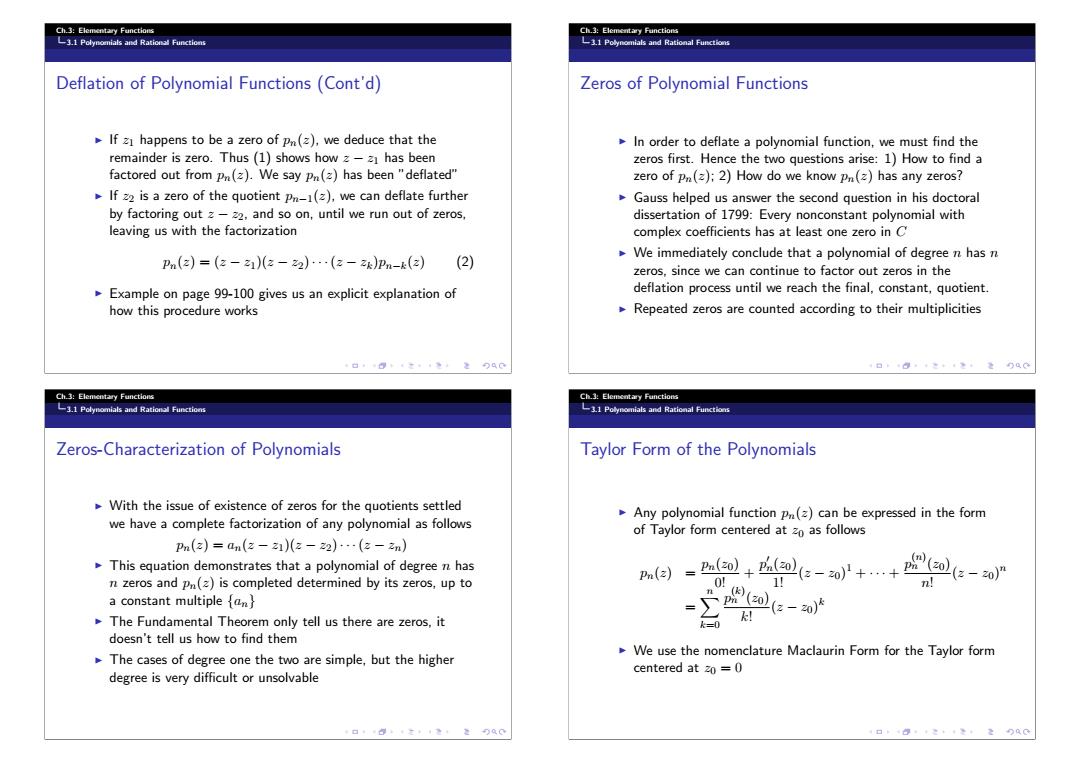正在加载图片...

Ch.3:Elementary Functions Ch.3:Elementary Functions L3.1 Polynomials and Ration Functions L3.1 Polynomials and Rational Functions Deflation of Polynomial Functions(Cont'd) Zeros of Polynomial Functions If z1 happens to be a zero of pn(z),we deduce that the In order to deflate a polynomial function,we must find the remainder is zero.Thus(1)shows how z-z1 has been zeros first.Hence the two questions arise:1)How to find a factored out from pn(z).We say pn(z)has been"deflated" zero of pn(z);2)How do we know pn(z)has any zeros? If z2 is a zero of the quotient pn-1(z),we can deflate further Gauss helped us answer the second question in his doctoral by factoring out z-z2.and so on,until we run out of zeros, dissertation of 1799:Every nonconstant polynomial with leaving us with the factorization complex coefficients has at least one zero in C p(z)=(z-)(z-22)…(z-2)pm-k(z)(2) We immediately conclude that a polynomial of degree n has n zeros,since we can continue to factor out zeros in the Example on page 99-100 gives us an explicit explanation of deflation process until we reach the final,constant,quotient. how this procedure works Repeated zeros are counted according to their multiplicities Ch.3:Elementary Functions Ch.3:Elementary Functions 3.1 Polynomials and Rationol Functions 3.1 Polynomials and Rational Functions Zeros-Characterization of Polynomials Taylor Form of the Polynomials With the issue of existence of zeros for the quotients settled Any polynomial function pn(z)can be expressed in the form we have a complete factorization of any polynomial as follows of Taylor form centered at zo as follows pm(2)=am(z-21)(z-22)…(z-2n)) This equation demonstrates that a polynomial of degree n has -ω+e-++m-or n zeros and pn(z)is completed determined by its zeros,up to Pn(z) .01 1! (k) a constant multiple fan =ae-0 The Fundamental Theorem only tell us there are zeros,it k=0 doesn't tell us how to find them We use the nomenclature Maclaurin Form for the Taylor form The cases of degree one the two are simple,but the higher degree is very difficult or unsolvable centered at zo =0Ch.3: Elementary Functions 3.1 Polynomials and Rational Functions Deflation of Polynomial Functions (Cont’d) If z1 happens to be a zero of pn(z), we deduce that the remainder is zero. Thus (1) shows how z − z1 has been factored out from pn(z). We say pn(z) has been ”deflated” If z2 is a zero of the quotient pn−1(z), we can deflate further by factoring out z − z2, and so on, until we run out of zeros, leaving us with the factorization pn(z)=(z − z1)(z − z2)···(z − zk)pn−k(z) (2) Example on page 99-100 gives us an explicit explanation of how this procedure works Ch.3: Elementary Functions 3.1 Polynomials and Rational Functions Zeros of Polynomial Functions In order to deflate a polynomial function, we must find the zeros first. Hence the two questions arise: 1) How to find a zero of pn(z); 2) How do we know pn(z) has any zeros? Gauss helped us answer the second question in his doctoral dissertation of 1799: Every nonconstant polynomial with complex coefficients has at least one zero in C We immediately conclude that a polynomial of degree n has n zeros, since we can continue to factor out zeros in the deflation process until we reach the final, constant, quotient. Repeated zeros are counted according to their multiplicities Ch.3: Elementary Functions 3.1 Polynomials and Rational Functions Zeros-Characterization of Polynomials With the issue of existence of zeros for the quotients settled we have a complete factorization of any polynomial as follows pn(z) = an(z − z1)(z − z2)···(z − zn) This equation demonstrates that a polynomial of degree n has n zeros and pn(z) is completed determined by its zeros, up to a constant multiple {an} The Fundamental Theorem only tell us there are zeros, it doesn’t tell us how to find them The cases of degree one the two are simple, but the higher degree is very difficult or unsolvable Ch.3: Elementary Functions 3.1 Polynomials and Rational Functions Taylor Form of the Polynomials Any polynomial function pn(z) can be expressed in the form of Taylor form centered at z0 as follows pn(z) = pn(z0) 0! + pn(z0) 1! (z − z0)1 + ··· + p(n) n (z0) n! (z − z0)n = n k=0 p(k) n (z0) k! (z − z0)k We use the nomenclature Maclaurin Form for the Taylor form centered at z0 = 0���������������